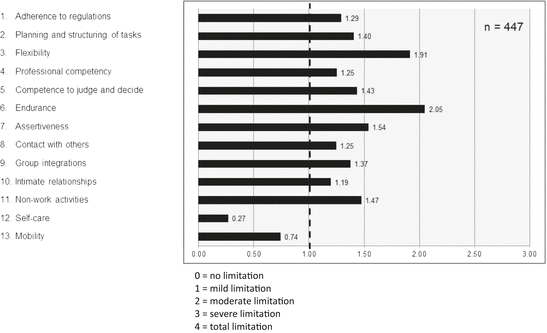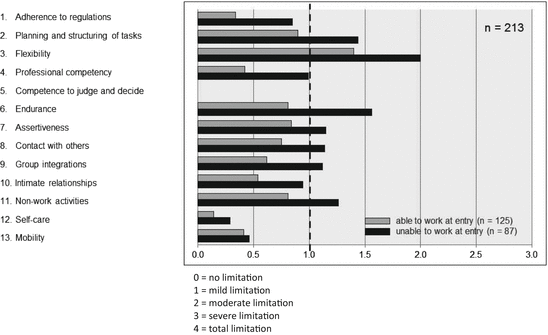Fig. 18.1
The functioning profile of the evaluated claimant. The dashed line indicates that, based on the underlying anchor definitions, ability limitations with a rating of “1” are considered to entail no significant negative consequences to date
Not limited in the ability for family and intimate relationships (item 10) and the ability for self-care (item 12).
Mildly limited in the ability for contact with others (item 8), the ability for group integration (item 9), and mobility (item 13).
Moderately limited in the ability for adherence to regulations (item 1), the ability for planning and structuring tasks (item 2), assertiveness (item 7), and the ability for performing nonwork activities (item 11).
Severely limited in flexibility (item 3), professional competency (item 4), competence to judge and decide (item 5), and endurance (item 6).
None of the assessed abilities is completely limited.
Based on the established functioning profile, the psychiatrist concluded that the claimant is no longer able to work in her former job as an executive leader. For a leadership position, assertiveness and the ability to make flexible decisions depending on the situation are particularly important. It is also crucial that a leader shows a high degree of endurance and is able to apply his or her professional competencies in stressful situations. In the claimant’s case, these abilities are limited to a degree that does not allow her to resume her former job. In an adapted job which takes into account the established limitations and does not involve extraordinary demands on the claimant’s psychological resilience, the psychiatrist considered the claimant’s reasonably manageable work capacity to be 40 % of a normal workload.
The legal framework of Switzerland requires medical experts to provide at the end of their reports an assessment regarding the percentage of a normal workload that is still reasonable for the claimant to perform in light of his or her health condition and functional limitations. From the medical expert’s point of view, it has to be emphasized that this percentage represents a judgment rather than a formal determination of the claimant’s work capacity. This judgment is strongly dependent on the expert’s clinical experience and cannot be derived directly from the Mini-ICF-APP rating. It remains part of the “medical art” and is, therefore, a subject of constant criticism [30]. However, the functioning profile of the Mini-ICF-APP provides useful information and could enhance the transparency and understandability of the expert’s judgment regarding the claimant’s work capacity. Disability claims adjudicators, for instance, need the exact percentage of a claimant’s residual work capacity in an adapted job so as to be able to determine the final degree of disability, which determines the amount of benefits the claimant is entitled to. The degree of disability is then calculated based on a comparison of two types of income. More specifically, the (potential) income of the claimant in an adapted job (AJ) is compared to the income received in his or her former job (FJ), i.e., degree of disability = 1 − (AJ/FJ). Thus, the lower the ratio of AJ to FJ, the higher the inferred disability.
18.3.3 Sample of Claimants Assessed with the Mini-ICF-APP
In MEDAS Zentralschweiz, the Mini-ICF-APP was introduced for psychiatric evaluations in 2010. In the meantime, the application of the Mini-ICF-APP has also been recommended by the “Guidelines on Psychiatric Evaluations for the IV” [9]. The Mini-ICF-APP tool was introduced gradually. Initially, only one psychiatric expert used it; from February 2011 onwards, four out of five psychiatrists working for MEDAS Zentralschweiz have been using it. In tandem with the introduction of the Mini-ICF-APP tool, MEDAS Zentralschweiz has embarked on a research study that recorded all reports that included a diagnosis of a work-related mental disorder in a database. Between February 2010 and May 2013, a total number of 1,148 multidisciplinary reports were prepared at the institute. Of these, 1,102 involved a psychiatric evaluation. However, the Mini-ICF-APP was only applied in those cases where a mental disorder could be diagnosed and where the impact of the disorder on activities and participation was to be assessed. In 446 out of the 1,102 psychiatric reports, this was not the case as the mental disorder was not deemed severe enough. Another 209 reports did indeed involve a mental disorder, but the respective medical expert had not yet applied the Mini-ICF-APP for the psychiatric assessment. In the end, a total of 447 claimants were assessed using the Mini-ICF-APP rating during the stated period of time. All of these assessments were included in the present data analysis.
18.3.4 Results of the Research Study
Of the 447 claimants assessed with the Mini-ICF-APP, 52.9 % were male and 47.1 % were female. The average age was 47.4 years for the women and 50.1 years for the men. The majority of the claimants suffered from an affective or a somatoform disorder. In fact, in most of these cases, there was a combination of several diagnoses. On the other hand, our sample only included eight reports with psychotic disorders. This is probably due to the fact that severely disabling forms of psychotic disorders are usually evaluated solely through psychiatric evaluation and do not require multidisciplinary evaluations like those provided by MEDAS Zentralschweiz.
The 13 abilities were assessed using the published anchor definitions [27]. The means of the assessments were calculated for the 447 psychiatric reports which included an evaluation with the Mini-ICF-APP. Figure 18.2 shows the average functioning profile over all assessments.


Fig. 18.2
Average functioning profile using the Mini-ICF-APP over all mental assessments
Overall, flexibility (item 3) and endurance (item 6) turned out to be the most limited abilities. Yet they prove particularly important in modern service industries. Limited flexibility and endurance can easily lead to situations where people with mental disorders are unable to achieve the required level of work performance. In addition, the following abilities are affected in descending order: assertiveness (item 7), ability for nonwork activities (item 11), competence to judge and decide (item 5), ability for planning and structuring tasks (item 2), ability for group integration (item 9), ability for adherence to regulations (item 1), ability to apply professional competencies (item 4), ability for contact with others (item 8), and ability for family and intimate relationships (item 10). Ability for self-care (item 12) and mobility (item 13) were rarely limited to a significant degree, except in severely depressed claimants who are affected by high doses of psychotropic drugs.
In Switzerland, medical experts are required to provide an appraisal of a claimant’s work capacity expressed as a percentage of a normal workload. As mentioned the IV system needs this information for calculating the degree of disability and determining the amount of disability pension benefits the claimant is entitled to.
An assumed work capacity of 70 % indicates that the medical expert considers it reasonable for the claimant to be expected to perform at 70 % of a normal workload in an adapted job. However, any such estimate as a percentage of the norm, and without specification of a confidence interval, is fraught with many uncertainties and has long been part of the criticism leveled against medical evaluations [30].
Therefore, we examined whether the functioning profiles of claimants with high attested work capacity significantly do indeed differ from the ones of claimants with low work capacity when using the Mini-ICF-APP. Figure 18.3 provides a comparison of the functioning profiles for these two groups.


Fig. 18.3
Differences in Mini-ICF-APP functioning profiles between claimants with high (≥70 %) and low (≤30 %) attested work capacity in an adapted job. WC work capacity
Figure 18.3 indicates clear differences between the two comparison groups. This suggests that the medical experts applied the Mini-ICF-APP tool in a consistent manner. The question, however, remains open as to how valid the work capacity ratings are that the medical experts derived from the functioning profiles, since no authoritative gold standard for these ratings currently exists.
18.3.5 Comparison with the Data of Linden and Baron
Linden et al. analyzed data from 213 patients who took part in a psychosomatic rehabilitation program [27]. In their study, they distinguished between patients who were able to work and patients who were unable to work at the time of admission to the clinic. Figure 18.4 illustrates the differences they found between the two groups with regard to their average Mini-ICF-APP functioning profiles.








